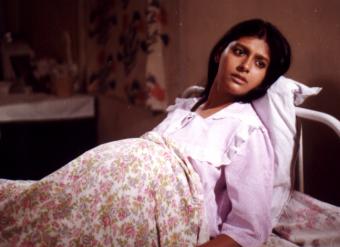 |
JANMADINAM
DER TAG DER GEBURT
THE
DAY OF BIRTH
Suma Josson
Indien 1998
Produktion + Weltvertrieb:
National Film Development Corporation, Ltd., India Discovery of India
Bldg., Nehru Centre, Dr. Annie Besant Rd., Worli, Bombay 400018
Tel. (91-22) 494 33 53, Fax 497 33 64.
Buch:
Suma Josson
Kamera: Hari Nair
Ausstattung: Alex Chand
Musik: Narayana Mani
Ton: Krishnan Unni
Darsteller: Nandita Das, Surekha Sikhri
Sprache: Malayalam
Format:
35mm, 1:1.37, Farbe Länge: 105 Minuten, 24 B/sek. |
| Sarasu
ist zur Entbindung in ein Krankenhaus gekommen. Amma, ihre Mutter, begleitet
sie, um ihr beizustehen. Während der Stunden des Wartens verlieren
Zeit und Raum ihre Gültigkeit. Sarasu, die als Fernsehreporterin
in Bombay arbeitet, führt ein Tagebuch, dem sie ihre innersten Gefühle
anvertraut. Dadurch erfahren wir, daß sie von ihrem Vater gezwungen
wurde, Raghu zu heiraten, obwohl sie Ajay, einen Kameramann, liebte. Eines
Tages, wenige Monate nach ihrer Heirat, ist sie in Bombay auf dem Weg
zu ihrem Mann. Unterwegs sucht sie Ajay auf. Es ist das Jahr 1993, und
es herrscht Bürgerkrieg. Nach dieser Begegnung muß Sarasu sich
endlich entscheiden. Und Amma erkennt, daß auch sie einen Standpunkt
einnehmen muß. „Suma Josson, Autorin, Poetin und Dokumentaristin,
hat ihrem Film eine nicht-lineare Struktur gegeben – ungewöhnlich
für einen indischen Film – und benützt sie ganz ungezwungen.
Obwohl sich das äußere Geschehen in einem Krankenhaus abspielt,
findet der größte Teil des Films in den Köpfen der beiden
Protagonistinnen statt, in ihrer beider Erinnerung an die Vergangenheit
und in ihren Visionen von der Zukunft. Mit einer solchen Struktur sind
wir, die wir an die Dauer-Diät linearen Erzählens gewöhnt
sind, nicht gerade vertraut. Sie besitzt jedoch eine unmittelbare Anziehungskraft,
die zu eigenen Gedankenprozessen anregt.“ |
Sarasu has come to the hospital
to deliver her baby. Amma, her mother, is with her, to assist her. The
actual time-span of the film is a single night which mother and daughter
spend at the hospital. But during the hours of waiting, time and space
lose their meaning. Sarasu, a TV-reporter working in Bombay, keeps a
diary into which she pours her inner-most feelings. We find out that
Sarasu was forced by her father to marry Raghu, although he was in love
with Ajay, a cameraman. A few months after her marriage, she passes
through Bombay to join her husband. On the way, she meets Ajay in his
flat. This is during the ‘93 communal violence in Bombay. In the
aftermath of this meeting, Sarasu is finally forced to make a choice.
And Amma realizes that she also has to take a stand, as a result of
Sarasu‘s choice. It is this unspoken, unseen, subtle tension between
mother and daughter, and a slow psychological unfolding of the personal
histories of the main characters, which form the content of this film.
“Suma Josson, poet, novelist and documentary filmmaker, has given
the film a non-linear structure – something seldom seen in Indian
cinema, but something with which she is very much at ease. Although
the present takes place in a hospital where Sarasu awaits the birth
of her child, most of the film takes place in the minds of the two protagonists,
in their memories of their past and their visions of their future. It
is a structure that we, fed on a steady diet of linear narratives, are
not well acquainted with, and yet, it has immediate appeal because it
mirrors our own thought processes.” Karthika S. Nair
|
Biofilmographie
Suma Josson wurde in Kerala geboren. Sie studierte am College
St. Teresa in Minnesota (USA) Englische Literaturwissenschaft. Danach
kehrte sie nach Indien zurück und arbeitete zunächst als Journalistin,
später wechselte sie zu einem Fernsehsender in Bombay. Seither dreht
sie Dokumentarfilme zu unterschiedlichen Themen. Ihr Dokumentarfilm Bombays
Blood Yatra (1993) über die Straßenkämpfe von 1993 fand
Anerkennung in Indien wie auch im Ausland. Außerdem stammen von
ihr die Dokumentarfilme 47 Seconds & After: Latur, Osmanabad (1994; über
das Erdbeben in Maharastra), Akbar Padamsee & the Last Image (1996; über
einen indischen Maler), Waste (1998; über den deutschen Künstler
Gerd Rohling und einen Lumpensammler). überdies ist sie eine bekannte
Dichterin und Autorin, die verschiedentlich in indischen bzw. internationalen
Zeitschriften publizierte. Sie hat drei Bücher veröffentlicht:
'Poems and Plays', 'A Harvest of Light' (eine Gedichtsammlung, erschienen
bei Orient Longman) und den Roman 'Circumferences' (erschienen bei Penguin).
JANMADINAM ist ihr erster Spielfilm.
Biofilmography
Born in Kerala, Suma Josson graduated in English Literature,
from the College of St. Teresa, Minnesota, USA. Having begun her career
as a journalist, she switched over to the visual medium. Since then she
has been making documentary films about various topics. Her documentary
film, Bombays Blood Yatra dealing with the 93 communal riots in Bombay,
has won wide acclaim in India and abroad. Her other documentary films
include, 47 Seconds & After: Latur, Osmanabad (about the earthquake in
Maharastra), Akbar Padamsee & the Last Image (about an Indian painter),
Waste (a film about Gerd Rohling, a German installation artist and ragpicker).
She is also a well known poet and fiction writer, and has published in
various Indian and international magazines. She has published three books,
'Poems and Plays', 'A Harvest of Light' (a collection of poems, Orient
Longman), and 'Circumferences' (a novel, Penguin). At present, she makes
documentary films for TVI, an Indian television company. JANMADINAM is
her first feature film. |